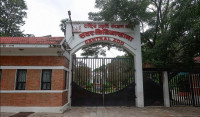Valley
Panel formed to reconstruct Hanumandhoka
Hanumandhoka Durbar Square, which was badly damaged by the Great Earthquake, finally got its own reconstruction committee this week after a three-month hiatus.
Gaurav Thapa
On Tuesday, Kathmandu Metropolitan City formed a 12-member Hanumandhoka Durbar Area Heritage Reconstruction Coordination Committee comprising local leaders, experts and stakeholder agencies which has been tasked with overseeing the reconstruction of damaged monuments within the Square. Committee members, however, said that they are yet to come up with formal plans for reconstruction and create further units under the committee for division of work according to expertise.
As proper long-term plans for reinstating Hanumandho- ka to its glory have not been created, formation of the committee in itself is a major step towards reconstruction, Heritage Conservation Section Chief of KMC Shriju Pradhan said. President of the Committee Narendra Bilas Bajracharya said, “We will hold formal meetings involving experts and
stakeholders in the coming days to give a final shape to the committee.”
According to Department of Archaeology, 26 structures including Kasthamandap temple, Maju Deval temple, Trailokya Mohan Narayan temple, Hanumandhoka palace complex, Narayan temple, Krishna temple, statue of King Pratap Malla, Degutalle temple, Kageshor temple and Nautalle Durbar have sustained damage due to the April 25 earthquake, with most of them in rubble. While DoA has taken the responsibility of reconstructing the museum housed inside Hanumandhoka palace, the reconstruction committee has been entrusted to rebuild monuments in its courtyard.
DoA Spokesperson Ram Bahadur Kunwar said the department is still in planning phase for reconstruction of heritage sites across the country including Hanumandhoka. He further added that the DoA has asked for a budget of Rs7-10 billion for the purpose, which is however yet to arrive.
Despite the late formation of the reconstruction committee, locals are optimistic on the reconstruction plans. Basanta Shrestha, who lives in the vicinity of the Durbar Square and is also one of the members of the committee, said their biggest concern was the involvement of locals in the reconstruction process. “We will ensure that rebuilding takes into consideration the sentiments of the local community and that quality materials are used,” he said.
According to KMC, it felt the need of forming the committee after several organisations were found trying to restore the damaged monuments on their own without coordination. The KMC is just providing leadership and coordination to their efforts, Pradhan said. She added that the entire amount collected from tourists visiting the area will go for reconstruction.
Built between the 12th and 18th centuries by Malla kings of Nepal, Hanumandhoka Durbar Square is listed in the Unesco’s World Heritage Sites. The site which boasts Newari architecture and Hindu temples was once used as a royal palace by Malla and Shah kings and is now a popular destination among tourists.




 27.54°C Kathmandu
27.54°C Kathmandu












